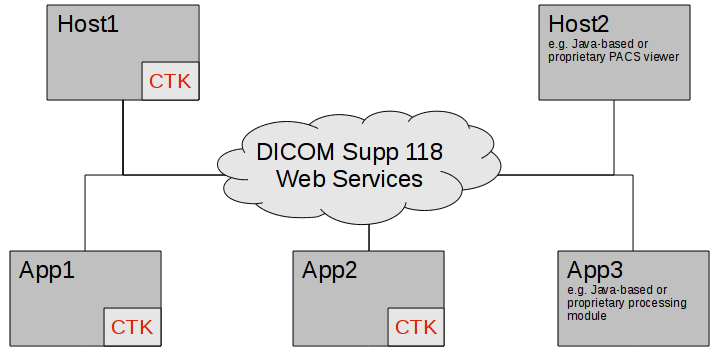IntegrationLevel1Details: Difference between revisions
MarcoNolden (talk | contribs) (Created page with '= Scenarios for integration on the DICOM Application Hosting level = == Scenario 1a == I have an application that I want to run integrated in an existing DICOM Application Host…') |
MarcoNolden (talk | contribs) No edit summary |
||
| (2 intermediate revisions by the same user not shown) | |||
| Line 1: | Line 1: | ||
= Scenarios for integration on the DICOM Application Hosting level = | = Scenarios for integration on the DICOM Application Hosting level = | ||
[[File:CTK-Level1.png]] | |||
== Scenario 1a == | == Scenario 1a == | ||
| Line 21: | Line 23: | ||
I use the CTK Dicom Application Hosting Module in my application to add intraoperability with a processing module available as a DICOM Hosted Application. | I use the CTK Dicom Application Hosting Module in my application to add intraoperability with a processing module available as a DICOM Hosted Application. | ||
[[CTKUsageScenarios|Back to overview ...]] | |||
[[File:Example.jpg]] | |||
Latest revision as of 09:03, 31 January 2011
Home < IntegrationLevel1DetailsScenarios for integration on the DICOM Application Hosting level
Scenario 1a
I have an application that I want to run integrated in an existing DICOM Application Host, e.g. a PACS viewer supporting DICOM Supplement 118.
Solution
I use the CTK Dicom Application Hosting Module in my application to add intraoperability with a DICOM Application Host. My application gets started by the host, data are passed according to DICOM Supplement 118.
Limitation
You cannot pass parameters to your application, so it either needs a GUI or has to do fully automatic parameterless processing.
Scenario 1b
I have an application, e.g. a PACS/DICOM viewer, that I want to extend with DICOM Application Hosting support.
Solution
I use the CTK Dicom Application Hosting Module in my application to add intraoperability with a processing module available as a DICOM Hosted Application.
